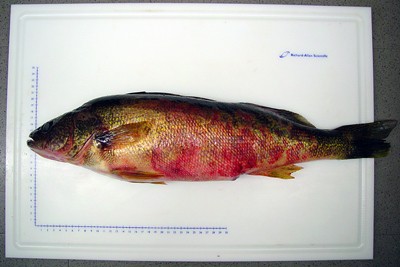Deadly fish virus now found in all Great Lakes
A deadly fish virus that was first discovered in the Northeast in 2005 has been found for the first time in fish from Lake Superior, report Cornell researchers. That means that the virus has now been documented in all of the Great Lakes.
The viral hemorrhagic septicemia virus (VHSV), which causes fatal anemia and hemorrhaging in many fish species, poses no threat to humans, said Paul Bowser, professor of aquatic animal medicine at Cornell's College of Veterinary Medicine.
Bowser and colleagues recently tested 874 fish from seven sites in Lake Superior in collaboration with the U.S. Geological Survey (USGS) Western Fisheries Research Center in Seattle. Fish from Paradise and Skanee in Michigan and St. Louis Bay and Superior Bay in Wisconsin tested positive. Some of the results have been corroborated by other laboratories; others have tests still under way.
The virus, which has been identified in 28 freshwater fish species in the Great Lakes watershed, has reached epidemic proportions in the Great Lakes and threatens New York's sport-fishing industry, said Bowser, estimated to contribute some $1.4 billion annually to New York's economy.
"People come from all over the eastern United States to fish the Great Lakes," said Bowser, noting that the virus has also been found in a few inland waters as well, including lakes, streams and a family-owned earthen pond. "The economy of many of these areas ebbs and flows with the season and perceived value of outdoor recreational opportunities. The value of these opportunities is dependent on how successful we are at managing the health of wild fish. On a worldwide basis, VHSV is considered one of the most serious pathogens of fish, because it kills so many fish, is not treatable and infects a broad range of fish species."
In 2008 the U.S. Department of Agriculture issued a federal order preventing transport of the 28 species within the Great Lakes watershed, including Lake Superior, to limit the spread of this viral pathogen. As a result, the new findings will not lead to additional regulatory actions, according to authorities.
While no significant fish mortality due to VHSV was observed in 2008 and 2009, "It is important to note that there are still fish harboring VHSV; essentially the infection proceeds even though no mortalities are being observed," said Bowser. "This is important because it suggests that these infected fish may serve as a reservoir for the virus in the Great Lakes ecosystem. While we don't fully understand the lack of recent mortality, the potential presence or absence of stressors on the fish may be playing a role."
The 2009 work was funded by the Cornell Agriculture Experiment Station and USDA APHIS. Cornell collaborators also include graduate students Emily Cornwell and Geof Eckerlin; and associate professors Mark Bain (natural resources, College of Agriculture and Life Sciences) and James W. Casey (microbiology and immunology, Vet College).
Media Contact
Get Cornell news delivered right to your inbox.
Subscribe
